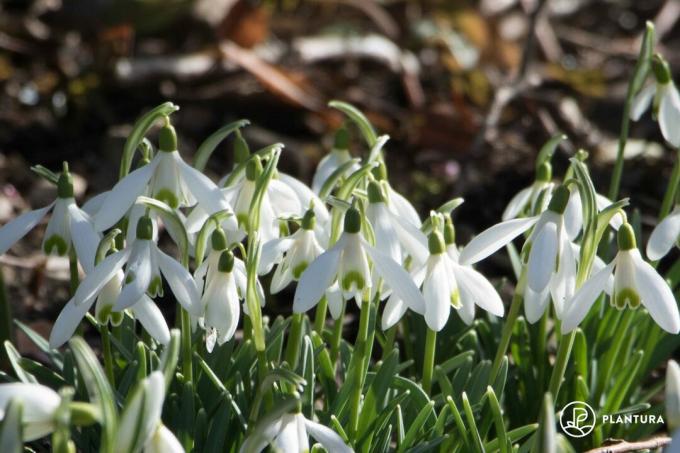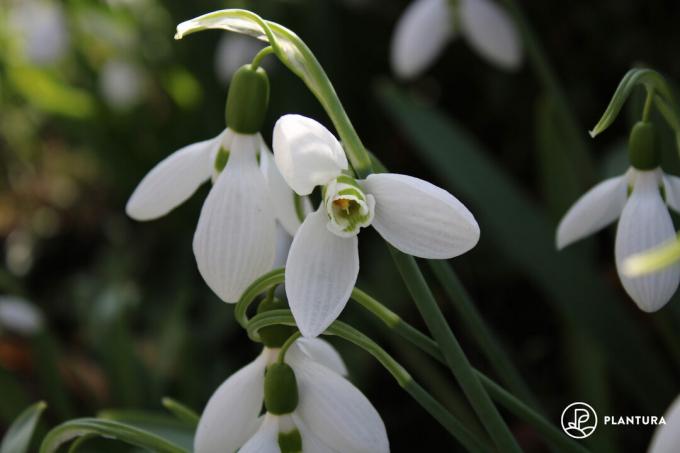Snowdrops ring in the new garden year. But not all snowdrops are created equal. We present the most beautiful species and varieties.

Snowdrops (Galanthus) cautiously push themselves out of the cold earth from January onwards. You are the first to scout a winter awakening world. With the typical white flowers and long green leaves, even in snow, they dispel the fear that winter will no longer end. The different species vary in terms of their external appearance and thus provide the necessary variety. Do you need more arguments to bring the graceful early bloomers into your own garden?
Snowdrop species
Snowdrops are perennial, herbaceous plants that are mainly found in the countries around the Black Sea. But also here in Central Europe one of the 20 species is native. The little snowdrop (Galanthus nivalis) extends its blossoms towards the first rays of sunshine from January to March, even when it is snowing. The German word snowdrops is derived from this species with its flowers that ring in spring. Together with the Turkish or giant snowdrops (
Galanthus elwesii) and the Voronov snowdrops (Galanthus woronowii) they are among the species most commonly sold as ornamental plants. Here are the differences:
- little snowdrop (Galanthus nivalis)
- Height: 7 to 18 cm
- Flowering period: December to April
- Flower: white with a green spot
- Leaves: long and bluish green
- Giant snowdrop (Galanthus elwesii)
- Height: 20 cm
- Flowering period: February to March
- Blossom: large flowers with broad, dark green stripes on the crown
- Leaves: broad and pale green
- Cope well in dry and sunny locations
- Voronov snowdrops (Galanthus woronowii)
- Height: 4 to 19 cm
- Flowering period: January to April
- Flower: white with greenish markings
- Leaves: broad and glossy
- Used as a remedy
There are three types that bloom as early as autumn. One of them is a subspecies of the Queen Olga snowdrops (Galanthus reginae-olgae) with a flowering period from September to December.
Note: It is tempting to pick a small bouquet of snowdrops at the edge of the forest. But the wild species have been under species protection since 1973. Therefore, please do not pick any wild snowdrops!

The most beautiful snowdrop varieties
For the layman, at first glance, there may not be any major differences between the around 500 registered snowdrop varieties (Galanthus) give. A galanthophile, as one calls snowdrop collector and lover, is more likely to see through. Galanthophiles have devoted themselves entirely to the heralds of spring with their pure white, greenish or yellow-centered flowers. There are also varieties with double flowers or characteristic patterns and drawings on the petals. In order to make you a real snowdrop fan too, we have put together a small selection of particularly beautiful varieties.

- 'April Fool': late flowering
- 'Atkinsii': tall; large bloom
- 'Bertram Anderson': huge flowers
- 'Big Boy': very large and massive flowers
- 'Blonde Inge': yellow ovary; yellow drawing
- 'Cordelia': double, large flowers
- 'Green Ibis': flowering in late March to April; green drawing of the petals
- 'Green Tear': green petals
- 'Maximus': vigorous; good for naturalization
- 'Mrs. Thompson ’: usually 5 instead of 3 petals; Possibly. 2 flowers / plant
- 'Spindlestone Surprise': flowering in February; very yellow ovary
- 'Straffan': up to two flowers per bulb
- ‘Titania’, ‘Flore Pleno’, ‘Hippolyta’: double flowers
- 'Wendy's Gold': yellow ovary, large drawing

It is not always possible to clearly determine which species a variety belongs to. Hybrid varieties are often grown, which makes assignment difficult. The more intensive breeding of the hybrids began in the middle of the 19th Century. After the Crimean War, soldiers brought native species to England. There these were crossed with the native species.
Robust, vigorous varieties such as 'Samuel Arnott', 'Warham Variety', 'Washfield Colesbourne' or 'Bill Bishop' are suitable for beginners in the snowdrop scene. Who knows, maybe you will soon count yourself among the proud lovers of the snowdrops.
Snowdrops are often confused with spring cups. You can find out how the two early bloomers differ in our article about the Märzenbecher.
